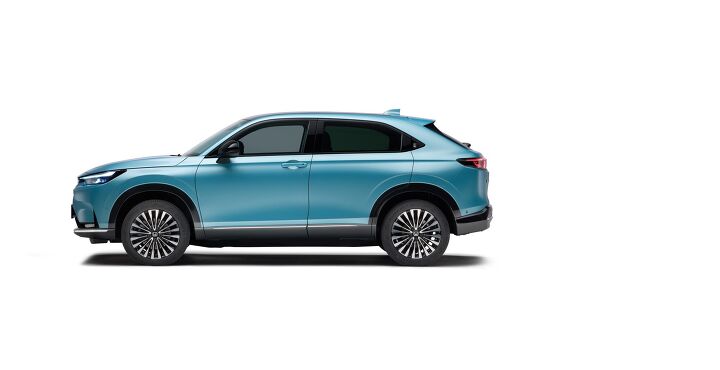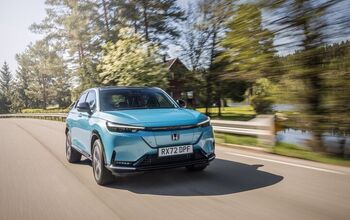Honda E:Ny1 Debuts in Europe

Honda raised the curtain for its second all-electric model for the European market this week. The e:Ny1 is an atrociously named battery-powered crossover that serves as the electrified counterpart to the Euro-spec HR-V. While not a formal debut, the Japanese manufacturer is teasing the EV’s design language and offering up some relevant details — perhaps foreshadowing things to come in North America.
Truth be told, small battery electric vehicles haven’t gotten an abundance of love in the United States. Consumers seem to prefer electrics with a premium bend. However, models like the Volkswagen ID.4 appear to be seeing higher demand as the months roll on. Maybe there would be room for something like the e:Ny1 in a few more years.
Utilizing Honda’s e:N Architecture F, the front-drive crossover has a chassis specifically designed for electric vehicles that’s supposed to be quite rigid. It also keeps the battery mounted low, creating a center of gravity ideal for pleasurable driving dynamics.
With an expected output of 201 horsepower and 229 lb-ft of torque, that sounds like a winning recipe for such a small vehicle. But we cannot forget that battery packs are exceptionally heavy and we don’t yet have any acceleration numbers. Your author has found small EVs boasting similar levels of torque to be quite a bit of fun around town. But they typically begin to lose their appeal when you begin approaching highway speeds.
The 68.8-kWh, lithium-ion battery is said to offer 256 miles of range on the overly generous WLTP cycle. American customers are going to want more than that because we cover more ground per day than the Europeans and our EPA will undoubtedly certify the e:Ny1 for fewer miles between charges. Though it is supposed to recoup energy relatively swiftly with DC fast charging — getting the battery from 10 to 80 percent in a claimed 45 minutes.
Honda’s design team has been on a roll of late, providing tastefully handsome models. The e:Ny1 borrows most of its design from the European HR-V. But it has a unique grille and little touches all around the exterior to distinguish itself from the gasoline and hybrid crossover. For example, rather than slapping an H on the tailgate, Honda opted to spell its name out in a font it seems to be receiving for EVs.
The interior likewise manages to be traditional, with just enough unique touches to differentiate itself from gasoline-powered models. The only real downside seems to be how heavily reliant controls seem to be on the touchscreen interface. There aren’t a lot of physical buttons in the cabin and all instrumentation comes by way of stuck-on digital tablets. While trendy, this is also one of the ways automakers cut manufacturing costs.
For now, the odds of the model making its way to North America seem relatively slim. Demand doesn’t seem to be high enough to rationalize such a move and Honda seems much more focused on pushing EVs in Europe and Asia. In fact, the e:Ny1 seems to be a carbon copy of the Chinese-market e:NS1.
“The e:Ny1 is the logical next step on our electrification journey in Europe,” stated Tom Gardner, Senior Vice President at Honda Motor Europe. “Our development philosophy blends intelligent, customer-centric technology with beautiful design and fun-to-drive dynamics. This latest SUV exemplifies Honda’s commitment to electrification and is the latest step on Honda’s electrification journey.”
It probably isn’t the vehicle for us. Not until EV acceptance increases and the maximum range of small battery electric vehicles improve. However, we wouldn’t mind seeing some of the exterior design elements migrating over to some of the products already sold here.
[Images: Honda]
Become a TTAC insider. Get the latest news, features, TTAC takes, and everything else that gets to the truth about cars first by subscribing to our newsletter.

A staunch consumer advocate tracking industry trends and regulation. Before joining TTAC, Matt spent a decade working for marketing and research firms based in NYC. Clients included several of the world’s largest automakers, global tire brands, and aftermarket part suppliers. Dissatisfied with the corporate world and resentful of having to wear suits everyday, he pivoted to writing about cars. Since then, that man has become an ardent supporter of the right-to-repair movement, been interviewed on the auto industry by national radio broadcasts, driven more rental cars than anyone ever should, participated in amateur rallying events, and received the requisite minimum training as sanctioned by the SCCA. Handy with a wrench, Matt grew up surrounded by Detroit auto workers and managed to get a pizza delivery job before he was legally eligible. He later found himself driving box trucks through Manhattan, guaranteeing future sympathy for actual truckers. He continues to conduct research pertaining to the automotive sector as an independent contractor and has since moved back to his native Michigan, closer to where the cars are born. A contrarian, Matt claims to prefer understeer — stating that front and all-wheel drive vehicles cater best to his driving style.
More by Matt Posky
Latest Car Reviews
Read moreLatest Product Reviews
Read moreRecent Comments
- Dartdude Having the queen of nothing as the head of Dodge is a recipe for disaster. She hasn't done anything with Chrysler for 4 years, May as well fold up Chrysler and Dodge.
- Pau65792686 I think there is a need for more sedans. Some people would rather drive a car over SUV’s or CUV’s. If Honda and Toyota can do it why not American brands. We need more affordable sedans.
- Tassos Obsolete relic is NOT a used car.It might have attracted some buyers in ITS DAY, 1985, 40 years ago, but NOT today, unless you are a damned fool.
- Stan Reither Jr. Part throttle efficiency was mentioned earlier in a postThis type of reciprocating engine opens the door to achieve(slightly) variable stroke which would provide variable mechanical compression ratio adjustments for high vacuum (light load) or boost(power) conditions IMO
- Joe65688619 Keep in mind some of these suppliers are not just supplying parts, but assembled components (easy example is transmissions). But there are far more, and the more they are electronically connected and integrated with rest of the platform the more complex to design, engineer, and manufacture. Most contract manufacturers don't make a lot of money in the design and engineering space because their customers to that. Commodity components can be sourced anywhere, but there are only a handful of contract manufacturers (usually diversified companies that build all kinds of stuff for other brands) can engineer and build the more complex components, especially with electronics. Every single new car I've purchased in the last few years has had some sort of electronic component issue: Infinti (battery drain caused by software bug and poorly grounded wires), Acura (radio hiss, pops, burps, dash and infotainment screens occasionally throw errors and the ignition must be killed to reboot them, voice nav, whether using the car's system or CarPlay can't seem to make up its mind as to which speakers to use and how loud, even using the same app on the same trip - I almost jumped in my seat once), GMC drivetrain EMF causing a whine in the speakers that even when "off" that phased with engine RPM), Nissan (didn't have issues until 120K miles, but occassionally blew fuses for interior components - likely not a manufacturing defect other than a short developed somewhere, but on a high-mileage car that was mechanically sound was too expensive to fix (a lot of trial and error and tracing connections = labor costs). What I suspect will happen is that only the largest commodity suppliers that can really leverage their supply chain will remain, and for the more complex components (think bumper assemblies or the electronics for them supporting all kinds of sensors) will likley consolidate to a handful of manufacturers who may eventually specialize in what they produce. This is part of the reason why seemingly minor crashes cost so much - an auto brand does nst have the parts on hand to replace an integrated sensor , nor the expertice as they never built them, but bought them). And their suppliers, in attempt to cut costs, build them in way that is cheap to manufacture (not necessarily poorly bulit) but difficult to replace without swapping entire assemblies or units).I've love to see an article on repair costs and how those are impacting insurance rates. You almost need gap insurance now because of how quickly cars depreciate yet remain expensive to fix (orders more to originally build, in some cases). No way I would buy a CyberTruck - don't want one, but if I did, this would stop me. And it's not just EVs.







































Comments
Join the conversation
I am imagining someone in the southern US pronouncing that model name...
Robin Masters...try to pronounce it the way you might sound out a vanity license plate. To me e:Ny1 says "enyl". Now pronounce that with a drawl. Sorry, maybe I have a dirty mind.